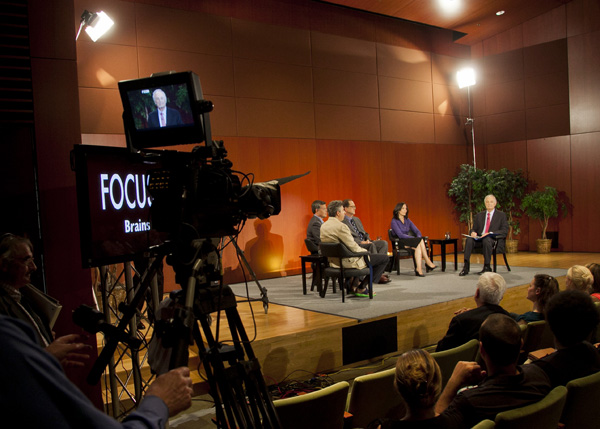Guest Post by Clara Colombatto T’15
Neuroscience research is finding its way into the legal system in an increasing number of cases. A panel of four Duke Professors explored the gap between laboratory and courtroom and its consequences on the attribution of guilt and responsibility in a Sept. 11 discussion at the Nasher Museum that was taped for broadcast on PBS-TV the next night.
“Every time we introduce new science into the courtroom, there’s an overconfidence by jurors in the science, as if that’s the objective truth,” said panelist Nita Farahany, Professor of Law, Genome Sciences and Policy, and Philosophy. But when transferring experimental evidence to real-life situations there are many caveats.

The panel discussion taping in the Nasher Museum Auditorium. Host Alan Alda is at right. (Megan Morr, Duke Photography)
Farahany played a significant role in the two-hour series “Brains on Trial,” a PBS special that explores the role and implications of recent advances in neuroscience in criminal justice. The show is hosted by Alan Alda, six-time Golden Globe winner and science journalist, who also moderated Wednesday’s discussion.
In addition to Farahany, the panelists were Ahmad Hariri, Professor of Psychology and Neuroscience and Investigator at the Institute for Genome Sciences and Policy, Scott Huettel, the Jerry G. and Patricia Crawford Hubbard Professor of Psychology and Neuroscience and Director of the Center for Interdisciplinary Decision Sciences, and Walter Sinnott-Armstrong, the Chauncey Stillman Professor in Practical Ethics in the Philosophy Department and the Kenan Institute for Ethics.
The Duke experts said neuroscientific evidence is starting to show the potential to determine, for example, if a witness is lying, if a juror is racially biased, if a brain disease impedes voluntary action, or if executive control regions are not yet developed in a juvenile defendant.
Some discoveries might save lives: Kent Kiehl, a professor of psychology, neuroscience and law at the University of New Mexico who has worked with Sinott-Armstrong, found that lower activity in the anterior cingulate predicts repeat offenses in psychopaths.
Hariri said his work is adding a piece to the puzzle by finding out how gene expression maps onto these brain pathways.
However, Scott Huettel points out that mistakes might arise from inaccurate generalization of function and anatomy that are unique to each individual, or from incorrect interpretation of a pattern of activation.
Hariri also warns about the risks of transferring results from an artificial laboratory setting to a real life situation which is subject to the forces of emotions and intentions.
Philosopher Sinnott-Armstrong raises ethical issues: brain imaging may violate privacy, and threaten our fundamental belief that we are in control of our thoughts, especially when those thoughts might be self-incriminating.
So the transfer of scientific evidence and legal cases is a sophisticated problem. While research advances, as Sinnott-Armstrong notes, “the court has to figure out the right procedure to minimize dangers while still extracting as much information as possible.”
